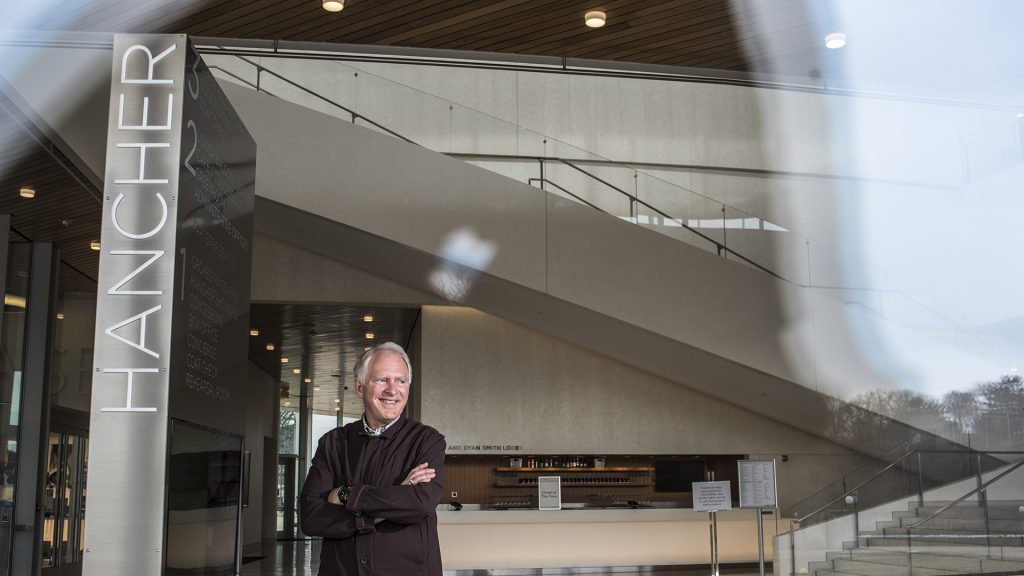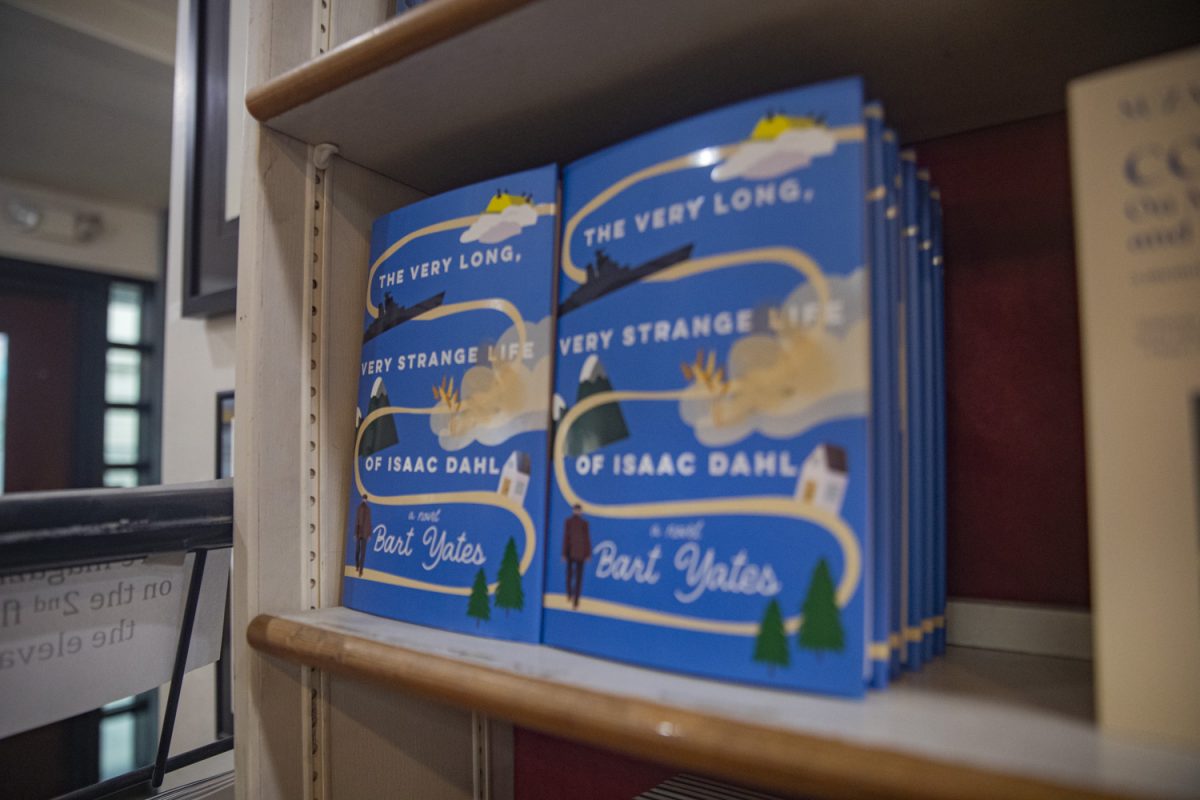When entering Hancher before an event, audiences encounter a lobby in which flat lights hang from the wooden ceiling and reflect off the marble floor as if they are displaying the contemporary architecture as artwork in itself.
Crowds in elegant clothing gather in Hancher’s Stanley Café, where they interact with each other over delectable desserts and beverages including champagne and pinot noir.
With gleaming faces and joyous laughter, audiences discuss the excitement and wonderment of an upcoming performance as anticipation rises.
Somewhere in this crowd, Hancher Executive Director Charles “Chuck” Swanson is most likely speaking admirably about the arts with new and returning audience members.
Swanson values the interactions that take place at Hancher prior to performances because they make live performances more meaningful and memorable. To Swanson, creating experiences that people remember is his most imperative aspiration.
In Swanson’s office, a bulletin board showcases photographs from his memories at Hancher. Among the photographs are a team selfie with Steve Martin, dance troupe members holding Swanson above their heads, and Swanson alongside exuberant donors who were as passionate about the arts as he was, including Dick and Mary Joe Stanley, the eponyms of Stanley Café.
RELATED: ‘Motown: The Musical’ leaves audiences in awe
“If people see him at any time, he’s just such a positive person,” said Hancher education manager Micah Ariel James, who coordinates opportunities for K-12th-grade students and university students. “He’s always smiling, he’s always laughing, [and] he loves to give tours. I love passing by him in the hallway as he’s giving a tour of the building because we have been here almost two whole years, and it never gets old for him. He loves seeing the smiles on people’s faces, he loves seeing people experience [Hancher] for the first time.”
During the summer of 2007, Hancher partnered with the Joffrey Ballet to celebrate the performing-arts center’s 35th anniversary and the ballet company’s 50th anniversary by organizing a “River to River” tour. This partnership brought five free outdoor performances to audiences across the state: Council Bluffs, Des Moines, Cedar Rapids, Iowa City, and Muscatine.
“[Chuck] has [a vision] for creating transformative artistic expressions for all Iowans,” said Zoë Woodworth, Hancher’s graphic-design director.
In Hancher’s lobby, an enlarged photograph of the Joffrey Ballet’s Iowa City “River to River” tour performance depicts hundreds of attendees watching the ballet dancers perform on stage outside the old Hancher.
However, Swanson faces the opposite direction of everyone else in the picture. Not only was he mesmerized by how many people attended the event on that day, he was delighted by the audience experiencing the ballet and interacting with those around them.
Art transforms lives and provides people with an outlet from difficult situations. Swanson recalls theaters experiencing greater attendance levels after 9/11 and a parade being held in metropolitan areas such as Detroit, when racial tensions were rising.
As a result, Swanson and his team strive to create opportunities in which real connections may be made among the artists and the audience as well as among the audience members. Helping create ways to transform people’s lives and provide an outlet for difficult situations in society remains at the forefront of Swanson’s mind.
Throughout his 33 years at Hancher, Swanson has emphasized that art is for all demographics, working to build relationships with a variety of community members and making them feel a sense of belonging.
Hancher’s stunning, impressive architecture beautifully reflects the intricacies of art, similar to the performances Hancher provides to audiences. However, Hancher’s extravagant aesthetic may intimidate people — a known obstacle that causes Swanson to encourage his staff members to acknowledge.
“Chuck often reminds us that Hancher is for everybody … we need to find ways to make this place a [comfortable] place for everybody … it’s impressive and beautiful, but it’s also intimidating,” said Hancher Marketing Director Rob Cline. “When [Chuck] is on campus or in the community and trying to build partnerships, he’s always willing and able to talk about the ways [in which] we are building a wider community.”
Since Hancher’s $176 million construction earlier this decade, its staff has focused on furthering community involvement to create new history and poignant connections in the new building.
RELATED: Dead venues don’t wear plaid
One can witness Hancher’s creative ways to broaden community involvement while walking through the facility, which is now lined with art pieces created by K-12th-grade students from several different schools around the local community.
Additionally, outside the Strauss Rehearsal Space, a seven-canvas-large painting depicts the artwork and creative writing project of seventh-grade students. Students from seven different communities developed the artwork by taking selfies, tracing them, and then writing about what performance means to them along the outlines of their selfies. These faces of the students, made real with their own words, were placed over a blueprint of the new Hancher.
Swanson’s passion and dedication to the arts and determination of instilling a sense of belonging in community members enabled him to provide endless educational and memorable experiences to audiences, regardless of the obstacles challenging these efforts.
When the Iowa River flooded in 2008, the old Hancher was ruined, leaving the organization without a home for eight years.
“When it flooded out, we were all heartbroken … we were all in a strange moment, [but] Chuck [never] lost faith,” Cline said. “He is the quintessential cheerleader for [Hancher]. His spirit of excitement and his faith that we could come back bigger and better than ever was utterly unwavering.”
Swanson’s leadership during Hancher’s construction process largely affected the way its surrounding communities experience art and interact with others.
Even Cesar Pelli, a well-known architect who evolved skylines into masterpieces, still considers Hancher in admiration.
Swanson said Pelli, who is now 91 years old, still informs people that Hancher was his favorite project.
For Swanson, an important component of the construction process was to express his and his team’s gratitude toward the construction workers who worked meticulously through frigid winter temperatures.
He arranged for some of his artistic friends, including Wycliffe Gordon and Susan Werner, to perform for them to show Hancher’s appreciation. Additionally, community members signed a beam that was built into Hancher’s architecture, making the community a part of Hancher’s DNA.
“The first performance in the new auditorium on [Hadley] Stage was [restricted to] the construction workers and their families,” Woodworth said.
Swanson’s care for the construction workers stems from a memory of the original Hancher’s construction process, during which a piece of scaffolding landed on two of the workers and killed them. In memory of the construction workers who lost their lives, a tree was planted in an area that is now the front lawn of the new Hancher.
Even more thoughtful, Swanson held a ceremony to bless the land where the new Hancher would be built, inviting Japanese-American drummers to perform at the ceremony.
Throughout the construction, Swanson also focused on keeping Hancher’s legacy alive while also improving Hancher for future generations and artistic needs.
“We knew what artists needed,” Swanson said. “Things we didn’t have in the original building, we wanted to make sure we had in this building.”
As a result, Swanson and his project team decided to incorporate a wardrobe room for costumes and laundry amenities, a visiting artists area in which artists spend time together when they are not rehearsing, and buffet lines, which allow staff members to provide food and beverages to the artists without having to set up and take down tables.
Most importantly, Hancher cut back the number of seats in the auditorium from 2,500 seats to 1,800 to establish a more intimate experience for the audience in hopes of increasing the opportunity for connections and memorable experiences.
“There’s no one warmer than a Hancher audience,” Swanson said. “The artists — with the warmth of the audience — leave here thinking [Iowa City] is one of the greatest places in the world.”
RELATED: Phil aids new Hancher
Every seat in Hancher has access to great sound and views of the performances, and the seats are quite close to the stage, seemingly erasing the line drawn between audiences and artists.
Eliminating this line also enables artists to have a more personable connection with the audience.
“Not only do we want audiences to have memorable experiences, but [we want] the artists to [encounter] memorable experiences [through our programming] as well,” said Programming Director Paul Brohan.
While sitting in the auditorium, it is as though everyone puts aside any differences they may have to come together and experience an amazing art form that will transform the ways in which they think and interact with each other.







